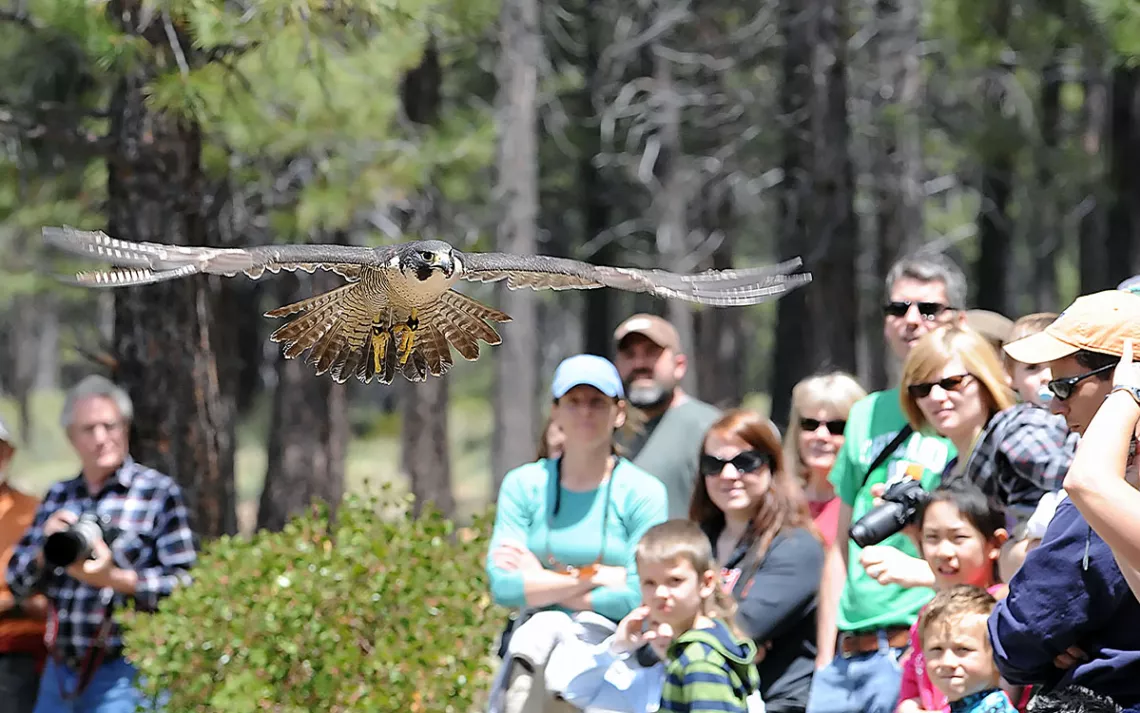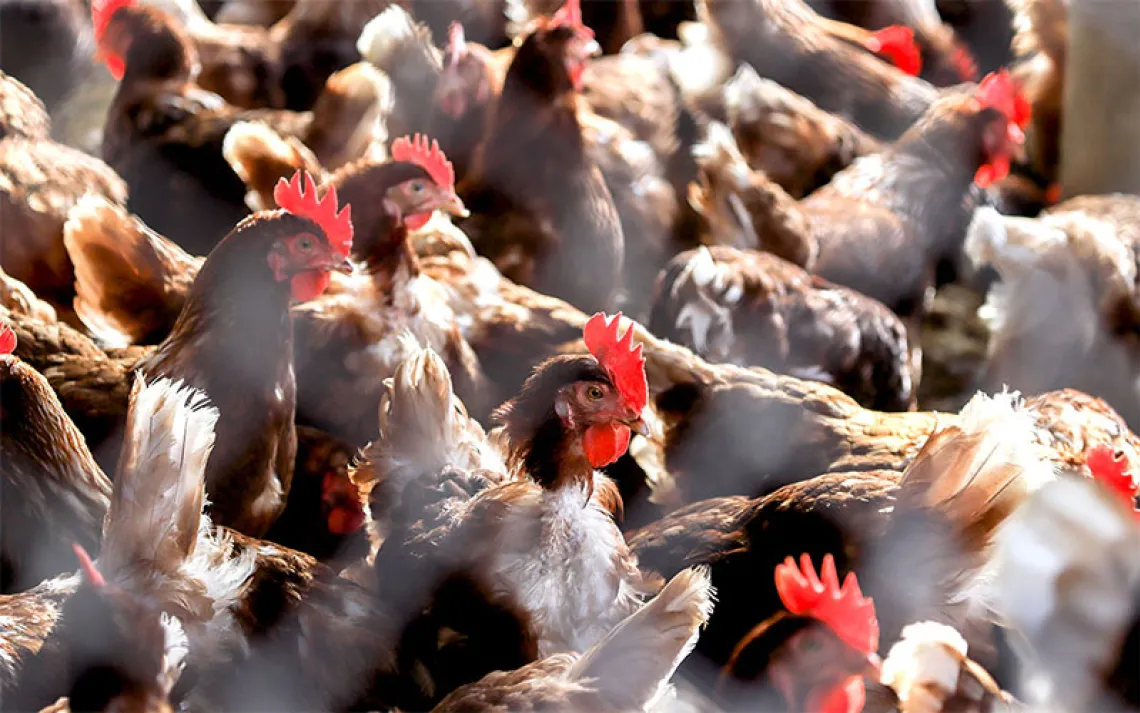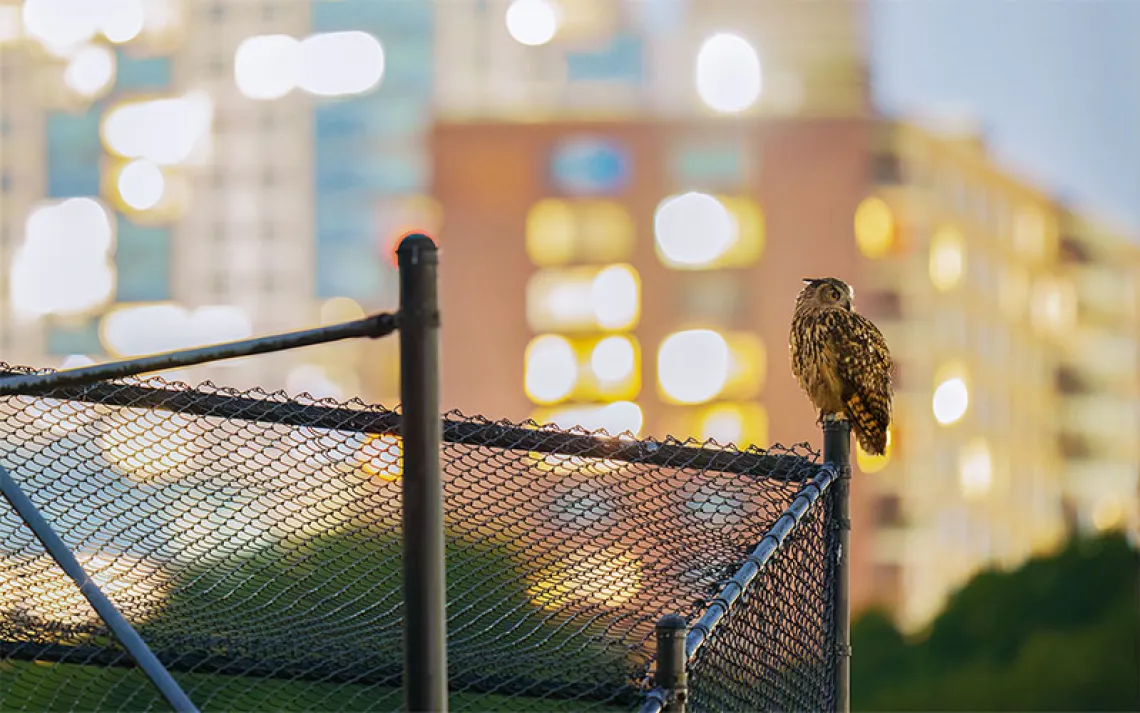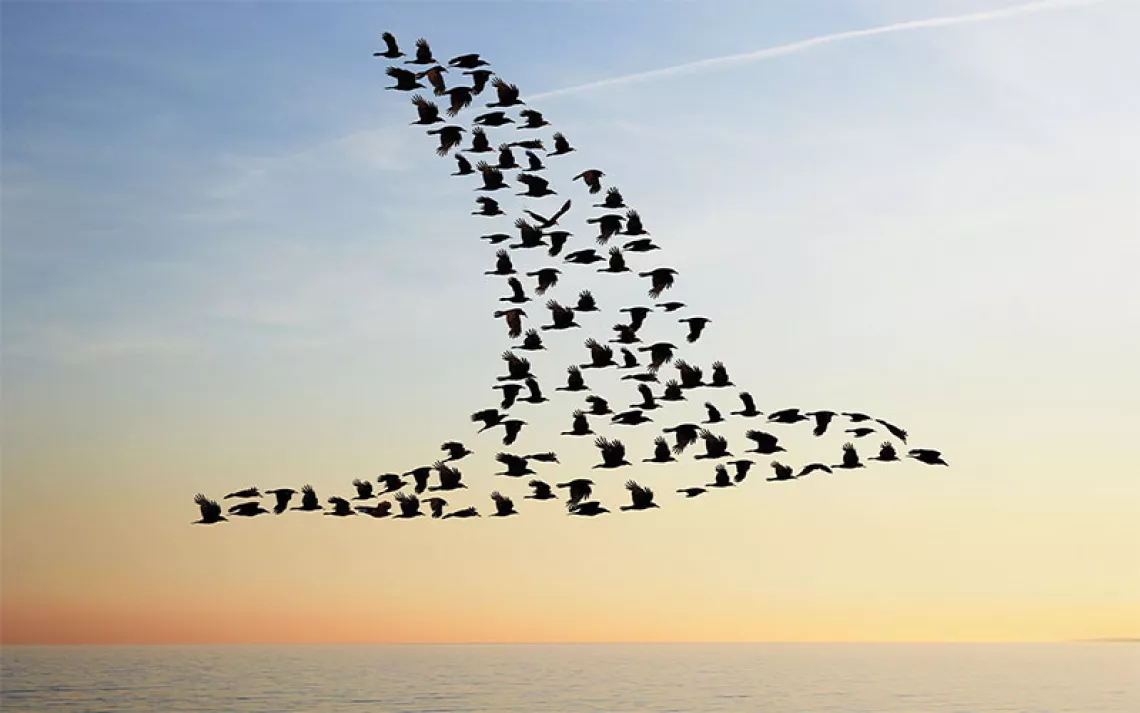How Raptors Cultivate Wonder in Oregon’s High Desert
To teach people the need to protect wildlife, this museum gives visitors close-up experiences

Raptors of the Desert Sky. | Photo by Lee Schaefer courtesy of High Desert Museum
After facilitating the High Desert Museum’s renowned “Raptors of the Desert Sky” show, Jon Nelson, the museum’s curator of wildlife, stood with a young peregrine falcon on his hand, answering visitors’ questions.
Six raptors had spent the last 30 minutes buzzing over the tops of visitors’ heads, and a crowd was excited to learn more about everything from how broken wings heal to how to protect raptors from pesticides. As Nelson answered, the falcon meticulously picked a quail to pieces, separating the feathers from flesh before swallowing it, bones and all. The falcon’s name is Hope, and she is one of a living collection of rescued, rehabilitated wild birds of prey that provide thousands of visitors every summer with powerful close encounters meant to spark a broader love of nature and the desire to protect it. This is Nelson’s daily life all summer. He’s worked this show every season since it started in 2010.
In a world filled with generalized zoos and natural history museums, the High Desert Museum—located on 135 acres of native pine forest five minutes south of Bend, Oregon, in the intermountain West—is unique for using history, culture, and ecology to celebrate the niches of one region. Situated in the rain shadow of the towering Cascade Mountains, the drier Great Basin and Columbia River Plateau regions contrast sharply with the dense green coniferous forests on the Cascades’ west side. This zone between the Rocky Mountains and Cascades is dominated by cold winters and dry hot summers that support a unique ecosystem of sagebrush scrublands, bunchgrass, and piney uplands. The museum’s exhibits and large collection tell the region’s story through Indigenous culture, the legacy of European settlement, contemporary artwork, and the experience of the vaqueros, Chinese, and Basque people who shaped the region.
One of the most incredible things about the museum is not what they do with the animals but what they do for them. Many show animals are born in captivity, and bred for that purpose. Most of the museum’s animals are rehabilitated rescues who won’t survive back in the wild. “They’re hard cases who have been deemed nonreleasable,” said Nelson. “Animals that have been turned down by zoos or organizations because they have behavioral problems, injuries, or disabilities. Nobody else is willing to take them on, and we give them another chance.”
Nelson has no collection plan that dictates the type of animals the museum houses or what exhibits the museum displays. He favors flexibility and a personalized approach. Staff evaluate each animal’s physical abilities, behavior, and personalities to determine whether or not it can spend time in an exhibit, show, classroom, summer camp, or field trip. The raptor show can include barn owls, turkey vultures, Harris’ hawks, Swanson’s hawks, and this young peregrine falcon named Hope.
But some birds prefer to stay behind the scenes. Nelson has five staff members caring for over 100 animals. A fraction of those animals are on exhibit. “We try to find a niche for each animal where it’s going to thrive the most and be the happiest here,” said Nelson.
Embodying the approach to learning that Rachel Carson spoke about in her book The Sense of Wonder, the raptor show favors visceral feeling over static information to cultivate the kind of wonder in visitors that hopefully makes them more conservation minded. Spectators sit on benches between ponderosas, as the raptors fly so close that feathers may brush their face. Visitors get incredible close-up views of these birds’ smart, probing eyes—something you would likely never experience in the wild. “People frequently describe it to me as ‘life changing,’” Nelson said. Just last week, while walking back from the show, a woman told him she felt that way after having a Swainson’s hawk wing brush her face.
“Regardless of whether they listen to the narration or not, the next time they see a hawk, they’re going to notice,” said Nelson. “Most of them are probably going to go home and read about wildlife, or take a greater interest, and that is going to influence decisions they make in the future.” Nelson hopes that visitors’ close encounters with wildlife at the museum make them more interested in governmental wildlife studies outside the museum, and might even make them more supportive of conservation efforts in general. For example, when visitors hear that the Oregon Department of Transportation is searching for the funds necessary to build wildlife crossings across roads, Nelson hopes this close-up experience will help them better understand the need to protect wildlife populations in that way.
Nelson grew up in rural Sandy, Oregon, fishing, hiking, and catching snakes and salamanders on his logging family’s forested property. As an adult, he spent the first 12 years of his career in a mill, breathing plywood dust. After moving to Bend, the recession hit, and he went back to school, still dreaming of becoming a wildlife biologist, when someone from the museum visited his community college class to recruit volunteers. Signing up to participate changed his life. He went from a volunteer to a seasonal employee, working on rotating exhibits that required animal care. Later, he became a contractor who conducted wildlife studies, and eventually moved on to associate curator and then lead curator. Seeing the profound effect the raptor show had on visitors, he decided to end school with his bachelor’s degree in natural resources rather than continue on to pursue his graduate degree, so he could continue to work for the museum.
Inspiring wonder and connection in laypeople is an aspect of environmental change-making that doesn’t get talked about as much as policy changes and litigation, but it’s equally important.
“If we’re going to turn things around, we really need to change the culture and the way people view and relate to wildlife,” said Nelson. “The museum is a kind of first step for many people to reconnect to the natural world.”
Every summer day, at 11:30 a.m., the raptor show begins. It’s so renowned that tickets often sell out by 10 a.m. The narrator of one recent summer’s show was entomologist Jerry Freilich. After spending 13 years as research coordinator at Olympic National Park in Washington, Freilich retired to Bend. The raptor show captivated him so much that he started volunteering at the museum. “I’d seen many live animal shows in my life,” he told the audience. “But when I sat here and saw this show, I thought it was pure, unbelievable magic.”
While Freilich narrated from the sidelines, Nelson and one other staffer walked the amphitheater’s perimeter, placing raw meat on trees that had been turned into perches. Using headsets, eye contact, and subtle signals, the two coaxed each raptor to fly across the seating area, tree to tree, and they managed to disappear into the periphery while everyone oohed and awed. The low flight paths that Nelson creates is the show.
Out front, people leave the museum with stuffed owls tucked under their arms, wearing hats with tarantulas on them, and staring into the little human-made stream that lines the entryway, taking one last glimpse of Oregon nature as they walk back to their cars and their lives beyond.
 The Magazine of The Sierra Club
The Magazine of The Sierra Club



